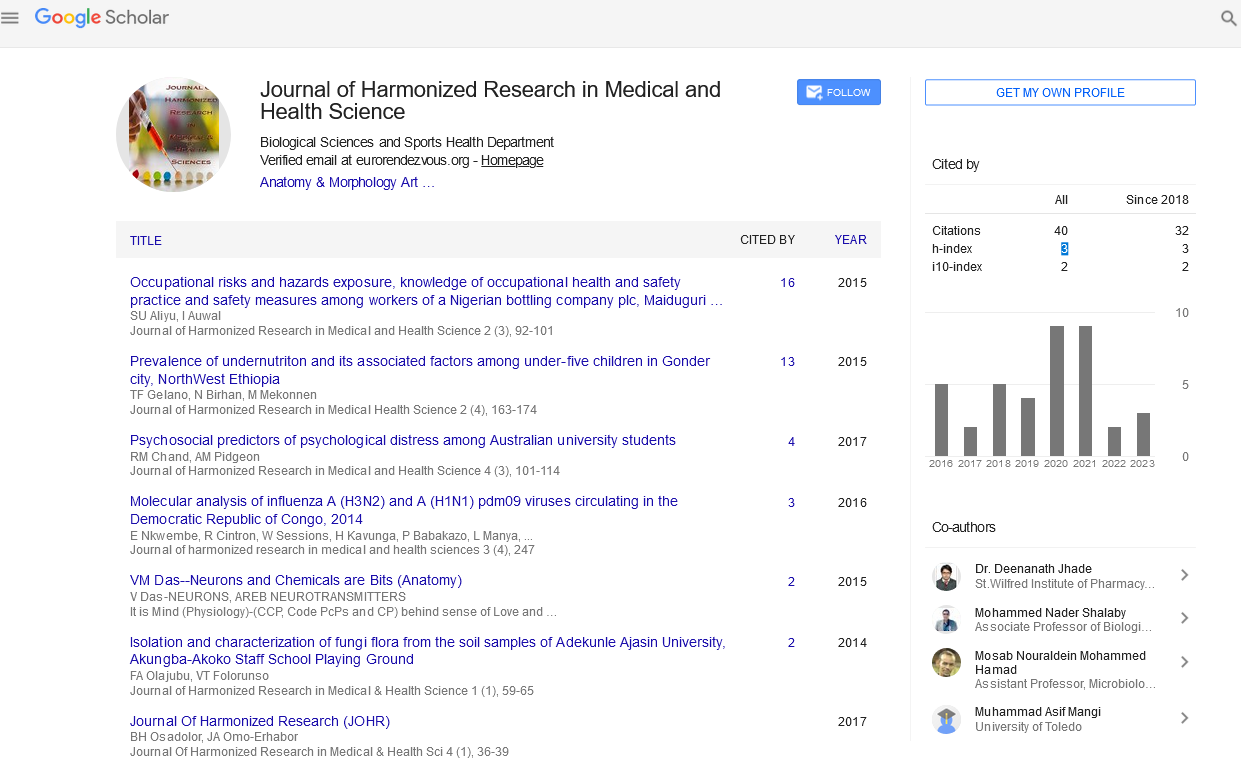Commentary - (2022) Volume 9, Issue 1
ROLE OF CELL SIGNALLING IN CELL METABOLISM
Zeng Hu*Received: Mar 01, 2022, Manuscript No. JHRMHS-21-38497; Editor assigned: Mar 03, 2022, Pre QC No. JHRMHS-21-38497; Reviewed: Mar 17, 2022, QC No. JHRMHS-21-38497; Revised: Mar 21, 2022, Manuscript No. JHRMHS-21-38497; Published: Apr 04, 2022, DOI: 10.30876/2395-6046.22.9.124
Description
In biology, cell signaling or cell communication is the capacity of a cell to receive, process, and transmit signals with its surroundings and with itself. Cell signaling is an essential prominent function in cells in all prokaryotes and eukaryotes. Signals that are generated from out of doors a cell (or extracellular indicators) may be physical agents like mechanical pressure, voltage, temperature, light, or chemical indicators (e.g., small molecules, peptides, or gas). Chemical indicators may be hydrophobic or hydrophilic. Cell signalling can arise over quick or lengthy distances, and as an end result may be labeled as autocrine, juxtacrine, intracrine, paracrine, or endocrine. Signalling molecules may be synthesized from diverse biosynthetic pathways and launched via passive or lively transports, or maybe from cell damage.
Receptors play an important role in cellular signaling because they can recognize chemical signals or physical stimuli. Receptors are proteins commonly found on or within cells, such as the cytoplasm, organelles, and nuclei. Cell surface receptors normally bind to extracellular signals (or ligands), causing conformational changes in the receptors, initiating enzymatic activity and opening and closing ion channel activity. Some receptors do not contain enzyme or channel-like domains and instead link to enzymes or transporters. Other receptors, such as nuclear receptors, have different mechanisms that alter DNA binding properties and intracellular localization in the nucleus. Signal transduction begins with the conversion (or transduction) of a signal into a chemical signal. Chemical signals either directly activate ion channels (ligand-bound ion channels) or initiate a second messenger system cascade that propagates the signal throughout the cell. The second messenger system can amplify the signal in which multiple second messengers are activated by the activation of several receptors, thereby amplifying the original signal (second messenger). Downstream effects of these signaling pathways may include additional enzymatic activity such as proteolytic cleavage, phosphorylation, methylation, and ubiquitination.
Metabolism is the set of life sustaining chemical reactions in organisms. The three main purposes of metabolism are: the conversion of the energy in food to energy available to run cellular processes; the conversion of food to building blocks for proteins, lipids, nucleic acids, and some carbohydrates; and the elimination of metabolic wastes. These enzyme catalyzed reactions allow organisms to grow and reproduce, maintain their structures, and respond to their environments. The word metabolism can also refer to the sum of all chemical reactions that occur in living organisms, including digestion and the transportation of substances into and between different cells, in which case the above described set of reactions within the cells is called intermediary (or intermediate) metabolism. Metabolic reactions may be categorized as catabolic – the breaking down of compounds (for example, of glucose to pyruvate by cellular respiration); or anabolic – the building up (synthesis) of compounds (such as proteins, carbohydrates, lipids, and nucleic acids). Usually, catabolism releases energy, and anabolism consumes energy.
The chemical reactions of metabolism are organized into metabolic pathways, in which one chemical is transformed through a series of steps into another chemical, each step being facilitated by a specific enzyme. Enzymes are crucial to metabolism because they allow organisms to drive desirable reactions that require energy and will not occur by themselves, by coupling them to spontaneous reactions that release energy. Enzymes act as catalysts – they allow a reaction to proceed more rapidly – and they also allow the regulation of the rate of a metabolic reaction, for example in response to changes in the cell`s environment or to signals from other cells.
The metabolic system of a particular organism determines which substances it will find nutritious and which poisonous. For example, some prokaryotes use hydrogen sulfide as a nutrient, but this gas is toxic to animals. The basal metabolic rate of an organism is a measure of the energy expenditure of all these chemical reactions. Cell signaling underlies important cellular decisions such as development, cell growth and division, differentiation, migration, and apoptosis, and essentially provides the necessary coordination for the functioning of multicellular organisms.










